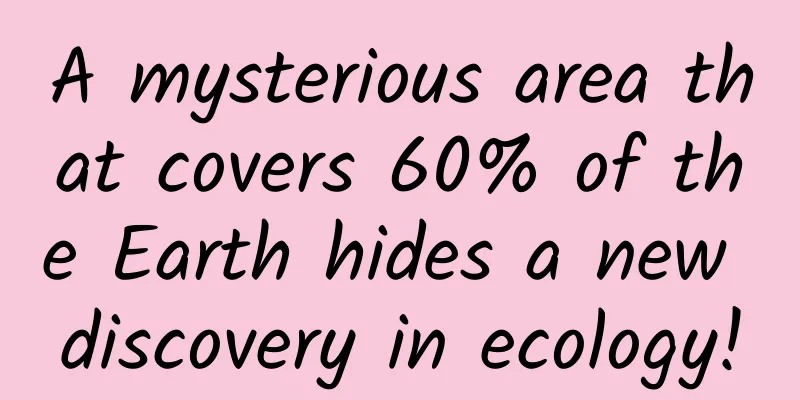A mysterious area that covers 60% of the Earth hides a new discovery in ecology!

|
Although human technology has enabled us to travel to Mars and almost reach every surface on Earth, our current understanding of the vast ocean is much less. Can you imagine that the abyssal plains occupy 60% of the earth's surface, but people still don't know much about the distribution pattern of organisms there. The biological communities here are in a fragile state of balance. Even a slight environmental change can rewrite the biological map of tens of thousands of square kilometers of the seabed, and even cause the extinction of a large number of organisms... A recent study gives us a new understanding of the underwater world. What kind of place is the deep sea? The vast ocean covers nearly 70% of the Earth's surface, but our understanding of it is still very shallow. In the vertical direction, the ocean includes continental shelves, continental slopes, abyssal plains, trenches, basins, submarine mountains, submarine canyons, submarine mountains and other terrains, with a maximum vertical depth of 11 kilometers. The most familiar comparison is that the Mariana Trench is deep enough to accommodate Mount Everest. A typical longitudinal section of an ocean basin, from left to right, from top to bottom: continental shelf, continental slope, abyssal plain, seamount, trench, volcanic island (Image source: National Oceanic and Atmospheric Administration) However, the common ocean structure diagrams like the one above lead to some misunderstandings - the seabed terrain is often steep and uneven. But in fact, the ocean is not like this. Except for most areas of the trench, the depth of the ocean decreases slowly, and the maximum slope of the continental slope is only about 26°. Therefore, in the real ocean, the most eye-catching terrain is the vast deep sea plain . Satellite remote sensing image of the western Atlantic Ocean basin. The dark blue area is the vast ocean basin (Image source: National Oceanic and Atmospheric Administration) The abyssal plain refers to the seabed located below the foot of the continental slope and above a depth of 6,000 meters (trench area). Its features are: 1) It is vast, covering 84.7% of the global seabed area (nearly 60% of the Earth's surface area). 2) It is relatively flat with little terrain undulation. It can be mainly divided into three types: deep-sea plains (<300 meters undulation), deep-sea hills (300-1000 meters undulation) and deep-sea mountains (>1000 meters undulation). 3) Covered by fine-grained sediments, such as silt, siliceous clay, etc. 4) The biomass is small and the overall biodiversity is not high. 5) The temperature is low and stable (0.5-3°C) and the flow rate is very small (0-0.25 m/s). 6) The lighting conditions are very weak. 7) Rely on organic matter input from surface waters to maintain its ecosystem. Due to the lack of sunlight, deep-sea creatures mainly rely on "pie in the sky", that is, organic particles that settle from shallow waters. This makes the overall energy of the deep-sea environment very limited. Therefore, traditional cognition holds that the deep sea cannot support high species richness and biomass, and as the depth increases, the energy supply decreases, and the species richness will become lower and lower. Anglerfish are representatives of deep-sea creatures. The picture shows the oceanic longfin anglerfish (Source: Miya et al. 2010. Evolutionary history of anglerfishes (Teleostei: Lophiiformes): a mitogenomic perspective. BMC Evolutionary Biology 10: 58.) Tips: What is species richness? It is part of biodiversity, which covers every level from micro to macro, including genetic diversity, species diversity, and ecological environment diversity. However, the latest research shows that the deep sea may not be as lonely as we previously thought. Although the biomass is not high compared to other marine environments, the deep sea still supports a high species richness. In addition, deep-sea habitats are a key link in the global carbon cycle. They are considered to be a reservoir of marine biodiversity and provide key services to the entire marine ecosystem. At the same time, the deep sea is also an area rich in polymetallic nodules, sulfides and other minerals, and is therefore also a key area for the exploitation of marine mineral resources. Manganese nodules, source: Koelle on de.wikipedia If we use five words to describe the characteristics of the deep sea, it is: stable but fragile. However, our understanding of the biogeographic distribution patterns of this largest biological community on Earth is still very limited, and it is imperative to improve the macroecological understanding of deep-sea habitats. In the deep sea, creatures are divided into two major "factions" Recently, a study published in the journal Nature Ecology & Evolution has for the first time depicted the biogeographic distribution of deep-sea organisms on a regional scale, taking a key step towards uncovering the mysteries of this unknown area. The research was carried out by scientists from the United Kingdom, Germany, Portugal, South Korea and other countries. The survey site was located in the Clarion-Clipperton Zone in the northeastern Pacific Ocean, spanning a vast deep sea area of 5,000 kilometers. Study area (Image source: Reference 1) The biggest challenges facing deep-sea macroecological research are the scarcity of biological data and the lack of standardization of methodology and taxonomy. The researchers integrated and reanalyzed image data from 28 locations in the northeastern Pacific Ocean to obtain the largest deep-sea biodiversity dataset, containing more than 50,000 large animal specimens larger than 10 mm, spanning 13 phyla. Through a detailed analysis of these data, the researchers summarized three key conclusions that are different from the past: Conclusion 1: Deep-sea creatures are not monolithic This study found that there are two distinct biological assemblages in the deep sea of the Clarion-Clipperton Zone. One is a relatively shallow biological assembly at a depth of 3,800-4,300 meters, and the other is a relatively deep biological assembly at a depth of 4,800-5,300 meters. Between these two biological assemblages, there is a transition zone of 4,300-4,800 meters. Two deep-sea biological assemblages and a transition zone discovered by researchers in the Clarion-Clipperton zone (Image source: Reference 1) What is bioassemblage? It can be understood as the composition of the biological community living in a certain area. What are the characteristics of the organisms in the shallow assemblage? Studies have found that soft corals and brittle stars (a class under the phylum Echinodermata) are the star organisms in this area . In the shallow area, the number of soft corals is as high as 2,500 per square kilometer, making them the superstars of this area. The number of brittle stars is also as high as 2,000 per square kilometer, which can still be called a superstar-level organism. These soft corals and brittle stars are like big trees in the forest, occupying an important position in the regional ecosystem. A soft coral, Isidella tentaculum (top), and an olivine, Ophiocoma erinaceus (bottom). (Image credit: NOAA, Maéva Bovio) The ecological stage in the deep area has obviously changed. The number of soft corals and brittle stars has dropped sharply, with only about 100 per square kilometer. Instead, two new "superstars" have emerged: sea anemones and sea cucumbers. Sea anemones stand upright on the seabed like fleshy mouths. They do not need skeletons to support them and are more suitable for living in the deep sea environment lacking food and calcium. The number of sea anemones can reach 1,500 per square kilometer, and there are also a considerable number of sea cucumbers, about 500. A sea anemone, Actinoscyphia_aurelia (top), and a sea cucumber, Chiridota heheva (bottom) (Image source: National Oceanic and Atmospheric Administration, Aquapix and Expedition to the Deep Slope 2007) Why are there such big differences in biological assemblages at different depths in the same area? It is difficult to explain this using only the traditional theory of organic matter particles and latitude changes. The specific reasons will not be discussed here. Let's look at the second conclusion drawn by the researchers. Conclusion 2: The depth has increased, but the number of species has not decreased The study found that although there are differences in biological assemblages at different depths, the total number of species (richness) remains at a similar level, which deviates from the previous view that the richness of deep-sea species will decrease as nutrients decrease. The study mainly involves species diversity at the phylum level, which can be simply understood as the total number of species found in an area . For example, if there are 10 species of fish, 5 species of shrimp, and 3 species of shellfish in a lake, then the species richness of the lake is 10+5+3=18 species. In the past, it was believed that as one moves farther from the sea surface, sunlight, food and other resources decrease, and the number of species that deep sea areas can support will also decrease. However, this new study found that although the biological combinations of the deep sea areas at 4,000 meters and 5,000 meters are different, the number of species in each area is still similar, about 50-60 species. As can be seen from the figure, as the depth (horizontal axis) increases, the species richness (vertical axis) at higher taxonomic levels does not decrease, but even increases (Image source: Reference 1) How is this achieved? Researchers believe that it is mainly achieved in two ways: 1) Species replacement between different categories There are many soft corals and brittle stars in the shallow areas, although they decrease in the deeper areas, and are replaced by anemones and sea cucumbers. So from the macrotaxonomic unit point of view, although the biological combination is different, the total number of species is similar. 2) Species distribution is more even In shallow areas, there are a few dominant populations with large numbers, while in deep areas, the number gap between different populations is reduced and more even. For example, in the relatively shallow 4,000-meter area, the top 10 species account for 60% of the total, while in areas deeper than 4,800 meters, the top 10 species account for only 40%. This means that species distribution in deep areas is more even. Simply put, the deep sea has achieved "job adjustment and recruitment", combining organisms of different categories and populations together to maintain richness. Now, it's time to uncover the mystery. What is the reason behind the changes in biological composition and the maintenance of diversity? Researchers believe that this may be related to an important environmental factor in the ocean, that is, the calcium carbonate compensation depth - CCD. What is CCD? A concept that determines the distribution of deep-sea biodiversity CCD is the abbreviation of Carbonate compensation depth, which is called calcium carbonate compensation depth in Chinese. It refers to the depth at which calcium carbonate in seawater begins to fail to precipitate and settle. First of all, we need to know that the ocean is a huge reservoir of chemical substances. Various ions and compounds are dissolved in the sea water, such as ions of metal elements such as calcium, magnesium, sodium, iron, as well as sulfate ions, chloride ions, etc. These include calcium ions and carbonate ions, which combine in seawater to form calcium carbonate, a major component of the skeletons and shells of many marine organisms and vital to many organisms. The existence of calcium carbonate in seawater is a dynamic equilibrium process, which involves dissolution and precipitation. Calcium carbonate in shallow seawater is relatively saturated and can precipitate to form biological skeletons. However, as the depth increases, the pressure increases, and the temperature decreases, the concentration of carbon dioxide in seawater will increase. When the depth reaches a critical point and the carbon dioxide content is high enough, it is difficult for calcium carbonate to precipitate from the seawater, but it will continue to dissolve. This critical depth point is the calcium carbonate compensation depth. CCD schematic by Paul Webb Below this depth, seawater dissolves calcium carbonate more than it precipitates it, so it is difficult to form calcium carbonate skeletons, which is a huge environmental pressure for organisms that rely on calcium shells. The calcium carbonate compensation depth becomes a crossroads between ocean chemistry and life activities, which affects the balance of carbon cycle and biogeographic distribution in the ocean. In the Clarion-Clipperton Zone, the CCD is located in the depth range of 4400-4800 meters. Does this number look familiar? Yes, it is exactly the depth range of the deep-sea biological transition zone discovered by researchers. In other words, the boundary between CCD and deep-sea biological assemblage almost coincides. Is this a coincidence? Calcium shells are a luxury for mollusks, and they require a lot of energy to maintain. Therefore, when the depth of calcium carbonate compensation is removed, the animals with calcium shells are gradually replaced by mollusks, which is an optimization of survival strategy. In the shallow deep sea, due to relatively more food input, there will be several populations with significantly higher numbers than other populations, while in the deep deep sea, the number of species is more evenly distributed. We know that factors that affect biodiversity include the size of the geographic range and the span of the environmental gradient. The factors that dominate the diversity pattern will also be different at different scales. In a large area like the Clarion-Clipperton Zone, where environmental conditions such as temperature and salinity are relatively stable, changes in the calcium carbonate compensation depth become a key factor in the distribution of biodiversity. On a smaller scale, changes in nutrient input in traditional theory play an important role. Are shelled creatures on the seafloor in trouble due to climate change? This groundbreaking study not only paints a new picture of the biogeographic distribution of deep-sea organisms, but also suggests that deep-sea ecosystems may be more complex than we thought. Calcium carbonate compensation depth, a seemingly subtle environmental change, can define the boundaries of organisms in vast deep-sea areas. Today, global climate change is causing ocean acidification, which means that the increased carbon dioxide in the atmosphere will be absorbed by the ocean, causing the pH value of seawater to drop, making calcium carbonate more soluble in seawater. This means that CCD may become shallower, and the depth at which calcium carbonate begins to dissolve will be shallower. If the CCD becomes shallower by tens of meters, considering the vast area and gentle slope of the deep sea, a vast "shoal" may be formed in the deep sea. This "shoal" is tantamount to a "land of death" for many deep-sea creatures that rely on calcium carbonate shells and skeletons. When they cannot survive in the environment, they will become extinct. This will lead to profound changes in the structure and composition of the entire deep-sea biosphere. At present, the exploitation of deep-sea mineral resources is ready to go. Once large-scale intervention in the deep-sea environment begins, the impact may be far beyond our imagination. Just imagine that a change in depth of just a few dozen meters of calcium carbonate compensation may change the seabed environment of tens of thousands of square kilometers, leading to changes in biota and population distribution. This is equivalent to pushing down a mountain with a change in the thickness of a piece of paper. Our understanding of the deep sea is still very limited, but this research is enough to make us realize that we are changing a complex, interconnected and highly sensitive ecosystem. In the face of the variables brought about by deep-sea mining, we need to remain humble and cautious. As Tagore said: "The song of the sea is so gentle, it needs no language and does not seek echo." How can we act rashly if we cannot understand the language of the deep sea? Main references: [1].Simon-Lledó, E., Amon, DJ, Bribiesca‐Contreras, G. et al. Carbonate compensation depth drives abyssal biogeography in the northeast Pacific. Nat Ecol Evol (2023). [2].PT Harris, M. Macmillan-Lawler, J. Rupp, EK Baker, Geomorphology of the oceans, Marine Geology, Volume 352, 2014. Author: Zhang Zhao This article is from the "Science Academy" public account. Please indicate the source of the public account when reprinting. |
<<: A must-have for May Day travel: How to understand ancient Chinese architecture (Part 1)
Recommend
Shenchen Panda Compass: Top Ten Marketing Methodologies (11 sections)
Shenchen Panda Compass: Top Ten Marketing Methodo...
Do you still remember the Ouija board game you played back then? Would you still be afraid if you tried it now?
Unconsciously, the popularity of the Pen Fairy Ou...
4000 words of Xiaohongshu video notes operation tips
2021 will still be a year of rapid development fo...
After 30 years, the Siberian tiger returns to Changbai Mountain
Recently, wild Siberian tigers have been spotted ...
The energy density of ternary lithium batteries is approaching its limit. When will solid-state batteries take on the responsibility?
At present, the development of pure electric vehi...
If you have 4 symptoms after a meal, beware of pancreatic cancer! Especially for this type of people
The pancreas Compared with the heart, liver, sple...
These 30 copywriting sentences are worth 30,000
Different classic copywriting has the same senten...
Tao Ge's "Love Map" Baidu Cloud Download
Tao Ge's "Love Map" Resource Introd...
Taobao may launch a function of refunding products within seconds! It will be convenient for online shoppers to return products
[[429889]] The annual "Double Eleven" i...
Zhang Ziyi and Wang Feng end their eight-year marriage. Does the "seven-year itch" really exist?
Wang Feng and Zhang Ziyi officially announced the...
ACEA: European new car registrations in September 2020 reached 1.3 million, up 1.1% year-on-year
Data released by the European Automobile Manufact...
A brief discussion on the development prospects of new media and community operations!
With social development and technological innovat...
IDC: China's tablet shipments in the second quarter of 2020 were approximately 6.61 million units, up 17.7% year-on-year
The latest tablet quarterly tracking report relea...
Look! Here is an analysis of the advertising placement of Qutoutiao!
As a rising star of Toutiao, advertisers certainl...
Kuaishou information flow advertising marketing method!
A detailed introduction to Kuaishou's informa...









